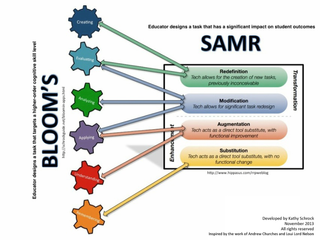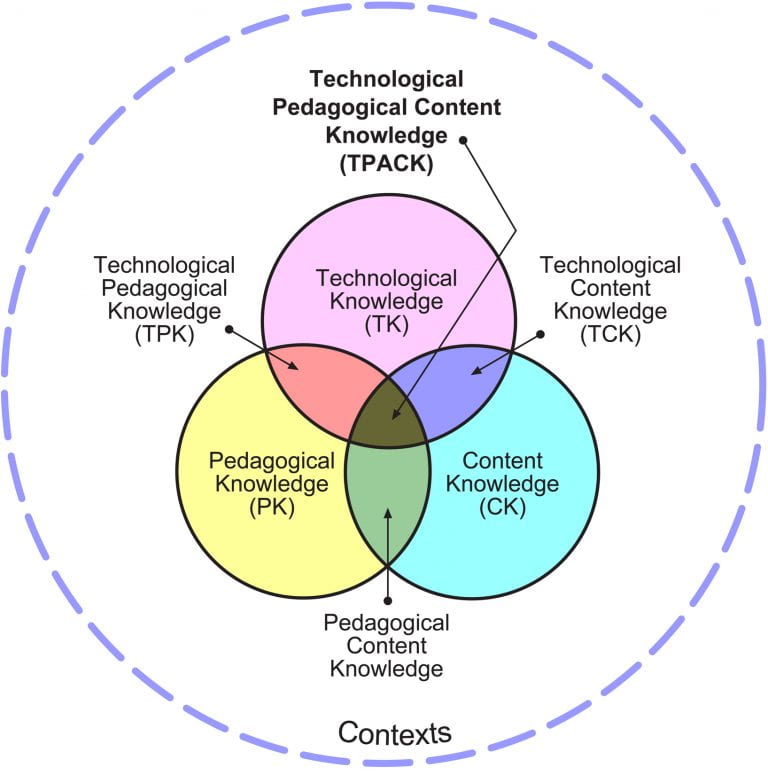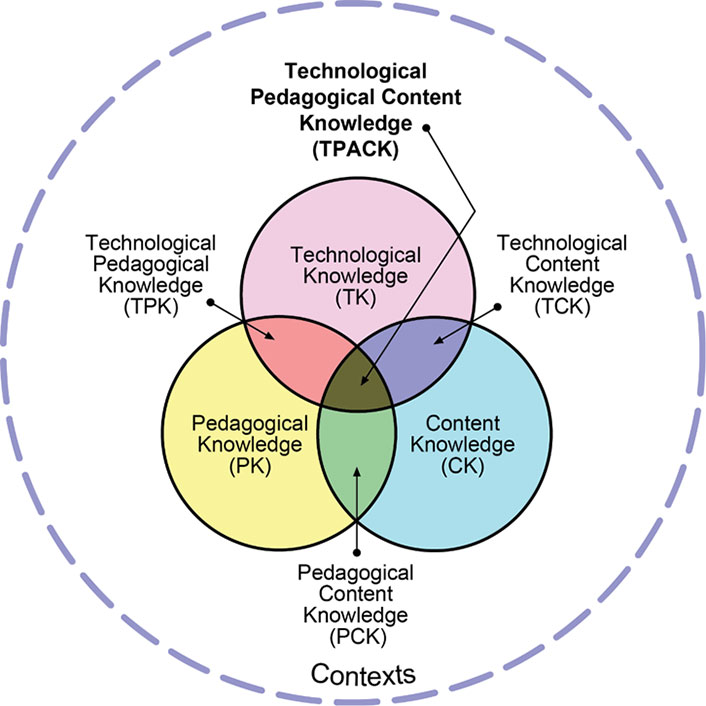Searching for "SAMR"
Better questions to ask might be:
- What is this project’s purpose, and is the technology that’s being used helping to achieve and enhance that purpose?
- Why is technology being used the way it is? Is it still effective?
- Is there a better way to accomplish this that we weren’t previously aware of or that we didn’t previously have access to?
iPads have come a long way since our initial investment in interactive whiteboards.
- Is there a better way to accomplish this that we weren’t previously aware of or that we didn’t previously have access to? iPads have come a long way since our initial investment in interactive whiteboards. Perhaps they can offer us a purposeful and innovative solution that wasn’t previously available.
+++++++++++++
more on SAMR in this blog
https://blog.stcloudstate.edu/ims?s=samr
Is SAMR Dead?
https://www.techlearning.com/news/is-samr-dead


++++++++++++++
more on SAMR in this IMS blog
https://blog.stcloudstate.edu/ims?s=samr
+++++++++++++++
more on SAMR in this IMS blog
https://blog.stcloudstate.edu/ims?s=samr
https://www.edsurge.com/news/2018-10-18-what-the-samr-model-may-be-missing
Developed by Dr. Ruben Puentedura, the SAMR Model aims to guide teachers in integrating technology into their classrooms. It consists of four steps: Substitution (S), Augmentation (A), Modification (M), and Redefinition (R).

The problem with many personalized learning tools is that they live mostly in realm of Substitution or Augmentation tasks.
It’s in moments like these that we see the SAMR model, while laying an excellent foundation, isn’t enough. When considering which technologies to incorporate into my teaching, I like to consider four key questions, each of which build upon strong foundation that SAMR provides.
1. Does the technology help to minimize complexity?
2. Does the technology help to maximize the individual power and potential of all learners in the room?
use Popplet and iCardSort regularly in my classroom—flexible tools that allow my students to demonstrate their thinking through concept mapping and sorting words and ideas.
3. Will the technology help us to do something previously unimaginable?
4. Will the technology preserve or enhance human connection in the classroom?
Social media is a modern-day breakthrough in human connection and communication. While there are clear consequences to social media culture, there are clear upsides as well. Seesaw, a platform for student-driven digital portfolios, is an excellent example of a tool that enhances human connection.
++++++++++++++++++++++
more on SAMR and TRACK models in this IMS blog
https://blog.stcloudstate.edu/ims/2018/05/17/transform-education-digital-tools/
more on personalized learning in this IMS blog
https://blog.stcloudstate.edu/ims?s=personalized+learning
https://www.edsurge.com/news/2020-12-16-now-is-the-time-to-redefine-learning-not-recreate-traditional-school-online
The vast majority of emergent virtual and hybrid learning models appear to be “stuck at substitution”—that is, they seek to recreate or translate the brick-and-mortar school experience into the cloud without stopping to ask which aspects of those models may not truly serve students in the time of COVID-19 or beyond.
When we say “stuck at substitution,” some readers may recognize the SAMR model of education technology integration. The SAMR framework describes four different levels of technology use, from Substitution to Augmentation, Modification and Redefinition (SAMR). At its most basic level, education technology can be used to simply substitute: to replace traditional methods of teaching and learning with ones that are digitally mediated, but are still based on the same basic structure and pedagogy.

edtech can be used for augmentation, to bring some other affordance or benefit to the teaching and learning experience—for example, when that worksheet becomes a shared Google Doc that allows for collaboration and increased critical thinking.
Redefinition means thinking beyond existing paradigms and schedules that are built for an on-campus experience. It is the opportunity to imagine entirely new ways of teaching and learning—for example, attendance policies that emphasize engagement versus seat time, blended learning models that leverage technology for anywhere, anytime learning, and instructional design that allows increased student choice and participation.
++++++++++++
more on online learning in this IMS blog
https://blog.stcloudstate.edu/ims?s=online+learning
https://www.facebook.com/groups/elearngdeveloping/permalink/10164385188890542/

How have you experienced the teachers move from face to face to online learning?
What is the biggest challenge created by the transition ?
How have you managed the challenge?
What are opportunities for instructors , regarding the transition to online learning ?
What have you done to ensure a smooth transition?
As previously mentioned the core of my arguments centre around the TPACK model. Based on the TPACK I propose that the move to online learning must be supported by the instatement of a Professional Development Program.
+++++++++++++++++
More on TRACK model and SAMR in this blog
https://blog.stcloudstate.edu/ims?s=track+model
https://www.facebook.com/groups/onlinelearningcollective/permalink/603803423583693/
Anyone in here teach instructional design that can recommend a textbook that teaches ADDIE or SAM but is inclusive and has an emphasis on instruction being culturally responsive or culturally sustaining?
Glenn Singley
https://community.articulate.com/articles/an-introduction-to-sam-for-instructional-designers
The ADDIE model of instructional design is probably the most well-known approach for crafting learning solutions. ADDIE stands for Analyze, Design, Development, Implement, and Evaluate. But ADDIE isn’t the only game in town these days. One popular alternative to ADDIE is SAM, which stands for Successive Approximation Model.
Created by Allen Interactions, SAM offers an instructional design approach consisting of repeated small steps, or iterations, that are intended to address some of the most common instructional design pain points, like meeting timelines, staying on budget, and collaborating with Subject Matter Experts
++++++++++++
more on ADDIE in this IMS blog
https://blog.stcloudstate.edu/ims?s=addie+model
https://blog.stcloudstate.edu/ims?s=SAMR
The Role of Librarians in Supporting ICT Literacy
Lesley Farmer May 9, 2019,
https://er.educause.edu/blogs/2019/5/the-role-of-librarians-in-supporting-ict-literacy
Academic librarians increasingly provide guidance to faculty and students for the integration of digital information into the learning experience.
TPACK: Technological Pedagogical Content Knowledge
Many librarians have shied away from ICT literacy, concerned that they may be asked how to format a digital document or show students how to create a formula in a spreadsheet. These technical skills focus more on a specific tool than on the underlying nature of information.
librarians have begun to use an embedded model as a way to deepen their connection with instructors and offer more systematic collection development and instruction. That is, librarians focus more on their partnerships with course instructors than on a separate library entity.
If TPACK is applied to instruction within a course, theoretically several people could be contributing this knowledge to the course. A good exercise is for librarians to map their knowledge onto TPACK.

ICT reflects the learner side of a course. However, ICT literacy can be difficult to integrate because it does not constitute a core element of any academic domain. Whereas many academic disciplines deal with key resources in their field, such as vocabulary, critical thinking, and research methodologies, they tend not to address issues of information seeking or collaboration strategies, let alone technological tools for organizing and managing information.
Instructional design for online education provides an optimal opportunity for librarians to fully collaborate with instructors.
The outcomes can include identifying the level of ICT literacy needed to achieve those learning outcomes, a task that typically requires collaboration between the librarian and the program’s faculty member. Librarians can also help faculty identify appropriate resources that students need to build their knowledge and skills. As education administrators encourage faculty to use open educational resources (OERs) to save students money, librarians can facilitate locating and evaluating relevant resources. These OERs not only include digital textbooks but also learning objects such as simulations, case studies, tutorials, and videos.
Reading online text differs from reading print both physically and cognitively. For example, students scroll down rather than turn online pages. And online text often includes hyperlinks, which can lead to deeper coverage—as well as distraction or loss of continuity of thought. Also, most online text does not allow for marginalia that can help students reflect on the content. Teachers and students often do not realize that these differences can impact learning and retention. To address this issue, librarians can suggest resources to include in the course that provide guidance on reading online.
My note – why specialist like Tom Hergert and the entire IMS is crucial for the SCSU library and librarians and how neglecting the IMS role hurts the SCSU library –
Similarly, other types of media need to be evaluated, comprehended, and interpreted in light of their critical features or “grammar.” For example, camera angles can suggest a person’s status (as in looking up to someone), music can set the metaphorical tone of a movie, and color choices can be associated with specific genres (e.g., pastels for romances or children’s literature, dark hues for thrillers). Librarians can explain these media literacy concepts to students (and even faculty) or at least suggest including resources that describe these features
My note – on years-long repetition of the disconnect between SCSU ATT, SCSU library and IMS –
instructors need to make sure that students have the technical skills to produce these products. Although librarians might understand how media impacts the representation of knowledge, they aren’t necessarily technology specialists. However, instructors and librarians can collaborate with technology specialists to provide that expertise. While librarians can locate online resources—general ones such as Lynda.com or tool-specific guidance—technology specialists can quickly identify digital resources that teach technical skills (my note: in this case IMS). My note: we do not have IDs, another years-long reminder to middle and upper management. Many instructors and librarians have not had formal courses on instructional design, so collaborations can provide an authentic means to gain competency in this process.
My note: Tom and I for years have tried to make aware SCSU about this combo –
Instructors likely have high content knowledge (CK) and satisfactory technological content knowledge (TCK) and technological knowledge (TK) for personal use. But even though newer instructors acquire pedagogical knowledge (PK), pedagogical content knowledge (PCK), and technological pedagogical knowledge (TPK) early in their careers, veteran instructors may not have received this training. The same limitations can apply to librarians, but technology has become more central in their professional lives. Librarians usually have strong one-to-one instruction skills (an aspect of PK), but until recently they were less likely to have instructional design knowledge. ICT literacy constitutes part of their CK, at least for newly minted professionals. Instructional designers are strong in TK, PK, and TPK, and the level of their CK (and TCK and TPK) will depend on their academic background. And technology specialists have the corner on TK and TCK (and hopefully TPK if they are working in educational settings), but they may not have deep knowledge about ICT literacy.
Therefore, an ideal team for ICT literacy integration consists of the instructor, the librarian, the instructional designer, and the technology specialist. Each member can contribute expertise and cross-train the teammates. Eventually, the instructor can carry the load of ICT literacy, with the benefit of specific just-in-time support from the librarian and instructional designer.
My note: I have been working for more then six years as embedded librarian in the doctoral cohort and had made aware the current library administrator (without any response) about my work, as well as providing lengthy bibliography (e.g. https://blog.stcloudstate.edu/ims/2017/08/24/embedded-librarian-qualifications/ and have had meeting with the current SOE administrator and the library administrator (without any response).
I also have delivered discussions to other institutions (https://blog.stcloudstate.edu/ims/2018/04/12/embedded-librarian-and-gamification-in-libraries/)
Librarians should seriously consider TPACK as a way to embed themselves into the classroom to incorporate information and ICT literacy.
+++++++++++++
more about academic library in this IMS blog
https://blog.stcloudstate.edu/ims?s=academic+library
more on SAMR and TRACK models in this IMS blog
https://blog.stcloudstate.edu/ims/2018/05/17/transform-education-digital-tools/
https://blog.stcloudstate.edu/ims/2015/07/29/mn-esummit-2015/
Digital tools can transform, not just replicate, the teaching and learning experience
Commentary: The Substitution Augmentation Modification Redefinition Model (SAMR) and the Technological Pedagogical Content Knowledge (TPACK) models of technology implementation can help schools as they transition to using more digital tools.
https://edscoop.com/digital-tools-can-transform-not-just-replicate-the-teaching-and-learning-experience
By EdScoop Staff May 8, 2018 2:37 PM
Digital tools can transform, not just replicate, the teaching and learning experience
Commentary: The SAMR and TPACK models of technology implementation can help schools as they transition to using more digital tools.
By EdScoop Staff MAY 8, 2018 2:37 PM
https://edscoop.com/digital-tools-can-transform-not-just-replicate-the-teaching-and-learning-experience
The SAMR (substitution, augmentation, modification, redefinition) model and TPACK (technological pedagogical content knowledge) model can help schools as they transition to using more digital tools.
In a recent edWebinar, Michelle Luhtala, library department chair at New Canaan High School in Connecticut, reviewed these models and discussed apps that can take teaching, learning and reading to the next level.
The SAMR model determines the level of technology integration of a tool: substitution, which doesn’t add value; augmentation, which adds a few features with only a little improvement; modification, which redesigns some structures; and redefinition, which allows the creation of new tasks and is the ultimate learning goal. Transformation in how educators are teaching and how students are understanding content happens in the modification and redefinition parts of the model.
MackinVIA’s Classroom allows educators to create a collection of digital content for students; build assignment around it; and share the collection, or an individual book, with the classroom. Students can also highlight text, make annotations, and save these to Google Drive.
Emerging Tech for Schools and Libraries is a free professional learning community where school librarians, teachers, and administrators can explore all the ways to integrate technology and 21st century learning into school library programs.
+++++++++++++++++++
more on the SAMR model in this IMS blog
https://blog.stcloudstate.edu/ims?s=samr





